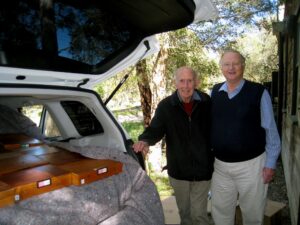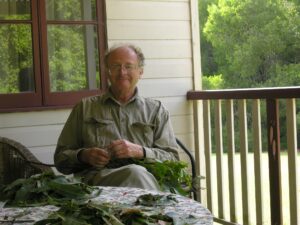Vale Edward (Ted) Edwards AM
Introduction by Toni Moate (Director, National Collections & Marine Infrastructure)
I’d like to take a moment to acknowledge the recent passing of Ted Edwards, an Australian National Insect Collection (ANIC) Lepidopterist.
Ted worked with ANIC for many years and then continued after retirement as a fellow. He was a valued member of our team and a great contributor to the Australian research community. I had the very great fortune of meeting Ted at the annual volunteer BBQs hosted by ANIC and his passion for the research and the volunteer program, and his genuine fondness for the people he worked alongside was evident.
I also like to share with you some beautiful words written about Ted by our incoming Chief Executive, Doug Hilton, who was a friend of Ted’s. These illustrate the impact Ted had on not only Doug, but also the wider community.
Sending my deepest condolences to those of our National Research Collections Australia team and extended CSIRO family who knew or worked with Ted, and I’m thinking of Ted’s wife and family during this time.
Lepidopterist, naturalist, author, CSIRO citizen, friend and father
12 October 1945 – 7 August 2023
Yesterday I found out that, after a long battle with cancer, my friend Ted Edwards died at his home in Canberra, surrounded by those who loved him. I am sad, not because it was unexpected, Ted knew he was dying for a while; but because life won’t be the same without him, the world is a little more pallid at a time we need all the color we can get.
Twenty years after falling in love with blood cells, I fell in love with moths and in 2005 found myself in the moth section of DF Waterhouse Laboratory of the ANIC at CSIRO’s Black Mountain site at the back of a long line of visitors outside Ted’s office. These acolytes were seeking advice on the identity of moths large and small, details of collecting sites from decades past or insight into obscure taxonomic conundra. Each one hung on Ted’s words like the naphthalene hung in the air. When my turn came, I nervously walked into his office, introduced myself and opened a little box containing one of the first moths I had collected, a tiny imperfectly pinned specimen. Ted was generous with his time, encouragement, and knowledge. Plucking a monograph from his bookshelf he opened it, almost immediately, to the page illustrating “my moth”, an undescribed Opostegidae annotated only as “Genus A species 1”. Ted’s knowledge from the field, the collection and the scientific literature was encyclopedic and incomparable.
I was hooked – it was as if Ted had opened an atlas with the coastlines of continents partially drawn and invited me on a journey of exploration. For that moment of generosity and inspiration, I will be forever grateful. Ted opened a new world to me, full of amazing discoveries, a community of passionate and quirky collaborators and trips to the most beautiful places across Australia.
Over the 50 years Ted worked at CSIRO as a staff member and honorary, he left a legacy of his own scientific achievements. He was the driving force behind the Checklist of Australian Lepidoptera, he co-described a new family of moths endemic to Kangaroo Island and co-authored two highly accessible books: A Guide to Australian Moths, and Moths in the ACT. His contribution to our nation was recognised when he was made a Member of the Order of Australia in 2012 and in 2016 his research was recognized when he received the highest award of the international Lepidopterists’ Society, the Karl Jordan Medal.
Ted was egalitarian, with no fuss or pretense. Although he treated everyone serious about moths in the same way, his super power was that he made everyone, including me, feel special. His legacy is amplified through those national and international peers with whom he collaborated, including Niels Peder Kristensen, Malcolm Scoble, Cathy Byrne, Peter McQuillan, Andy Williams, David Lees, George Gibbs and the late Ebbe Nielsen, through the valued CSIRO friends and colleagues like Marianne Horak, Michael Braby, Bobbie Hitchcock and Andreas Zwick with whom he worked, and through the legion of citizen scientists like John Landy, Glenn Cocking, Bart Hacobian, Len Willan, Marilyn Hewish, Fabian Douglas, Peter Marriot, Axel Kallies and John Kerr who he inspired and assisted.
Idealized reflections do not paint an accurate picture of Ted: he was far from anodyne. Ted’s passion could stray into self-righteousness, and I am sure he was “occasionally” a pain in the bum to those with whom he worked (or to whom he reported). Ted could be stubborn and annoyingly conservative, for example eschewing molecular approaches for taxonomy and phylogenetics for many years, before seeing them for what they are – useful adjuncts to more traditional approaches. Unlike everyone around him, at times, Ted doubted his own worth, focusing too much on the projects he was leaving unfinished rather than on the enormous contribution he had made. In the last few months, having come to terms with his own mortality, it was lovely to see Ted begin to view himself in the same way as those who knew him and to see him begin to understand the positive impact he had on the world, with the same sense of pride he had in the achievements of his friends and his children.
Ted was not perfect, but his strengths overwhelmed his shortcomings, something to which we can all aspire. CSIRO is a wonderful organization because of all of the ‘Ted Edwards’ who feel passionately about it, its place in Australian civil society and the good that it can do.
Thank you, Ted, we will miss you greatly.
Doug Hilton
Outgoing Director of WEHI
Incoming CEO of CSIRO
President of Moths and Butterflies Australasia and The Entomological Society of Victoria
Science Tragic

John Landy AC, Governor of Victoria, Olympian and Lepidopterist with Ted Edwards (right) at ANIC on the day John donated his collection.

Ted in a happy place – looking for larvae on leaves in Queensland
